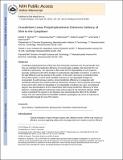| dc.contributor.author | Bonner, Daniel K. | |
| dc.contributor.author | Zhao, Xiaoyong | |
| dc.contributor.author | Buss, Hilda | |
| dc.contributor.author | Langer, Robert S | |
| dc.contributor.author | Hammond, Paula T | |
| dc.date.accessioned | 2016-02-12T18:42:59Z | |
| dc.date.available | 2016-02-12T18:42:59Z | |
| dc.date.issued | 2012-09 | |
| dc.date.submitted | 2011-09 | |
| dc.identifier.issn | 01683659 | |
| dc.identifier.uri | http://hdl.handle.net/1721.1/101176 | |
| dc.description.abstract | Crosslinked polyethylenimines (PEIs) have been frequently examined over the past decade since they can maintain the transfection efficiency of commercially available, 25 k branched PEI, but exhibit less cytotoxicity. The argument is often made that the degradability of such polymers, generally synthesized with either disulfide or hydrolytically degradable crosslinkers, is critical to the high efficiency and low toxicity of the system. In this work, we present a crosslinked linear PEI (xLPEI) system in which either disulfide-responsive or non-degradable linkages are incorporated. As with previous systems, strong transfection efficiency in comparison with commercial standards was achieved with low cytotoxicity. However, these properties were shown to be present when either the degradable or non-degradable crosslinker was used. Uncomplexed polymer was demonstrated to be the critical factor determining transfection efficiency for these polymers, mediating efficient endosomal escape without signs of cell membrane damage. While several crosslinked PEI systems in the literature have demonstrated the effect of the disulfide moiety, this work demonstrates that disulfide-mediated unpackaging may not be as important as conventionally thought for some PEI systems. | en_US |
| dc.description.sponsorship | National Institute for Biomedical Imaging and Bioengineering (U.S.) (Grant R01EB008082) | en_US |
| dc.description.sponsorship | National Science Foundation (U.S.). Graduate Research Fellowship | en_US |
| dc.description.sponsorship | National Cancer Institute (U.S.) (Center of Cancer Nanotechnology Excellence Grant 1U54CA151884) | en_US |
| dc.language.iso | en_US | |
| dc.publisher | Elsevier | en_US |
| dc.relation.isversionof | http://dx.doi.org/10.1016/j.jconrel.2012.09.004 | en_US |
| dc.rights | Creative Commons Attribution-NonCommercial-NoDerivs License | en_US |
| dc.rights.uri | http://creativecommons.org/licenses/by-nc-nd/4.0/ | en_US |
| dc.source | PMC | en_US |
| dc.title | Crosslinked linear polyethylenimine enhances delivery of DNA to the cytoplasm | en_US |
| dc.type | Article | en_US |
| dc.identifier.citation | Bonner, Daniel K., Xiaoyong Zhao, Hilda Buss, Robert Langer, and Paula T. Hammond. “Crosslinked Linear Polyethylenimine Enhances Delivery of DNA to the Cytoplasm.” Journal of Controlled Release 167, no. 1 (April 2013): 101–7. | en_US |
| dc.contributor.department | Harvard University--MIT Division of Health Sciences and Technology | en_US |
| dc.contributor.department | Massachusetts Institute of Technology. Department of Chemical Engineering | en_US |
| dc.contributor.department | Koch Institute for Integrative Cancer Research at MIT | en_US |
| dc.contributor.mitauthor | Bonner, Daniel K. | en_US |
| dc.contributor.mitauthor | Zhao, Xiaoyong | en_US |
| dc.contributor.mitauthor | Buss, Hilda | en_US |
| dc.contributor.mitauthor | Langer, Robert | en_US |
| dc.contributor.mitauthor | Hammond, Paula T. | en_US |
| dc.relation.journal | Journal of Controlled Release | en_US |
| dc.eprint.version | Author's final manuscript | en_US |
| dc.type.uri | http://purl.org/eprint/type/JournalArticle | en_US |
| eprint.status | http://purl.org/eprint/status/PeerReviewed | en_US |
| dspace.orderedauthors | Bonner, Daniel K.; Zhao, Xiaoyong; Buss, Hilda; Langer, Robert; Hammond, Paula T. | en_US |
| dc.identifier.orcid | https://orcid.org/0000-0003-4255-0492 | |
| mit.license | PUBLISHER_CC | en_US |
